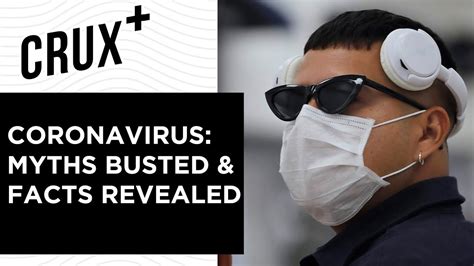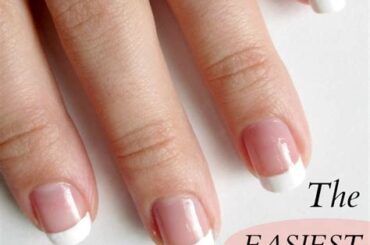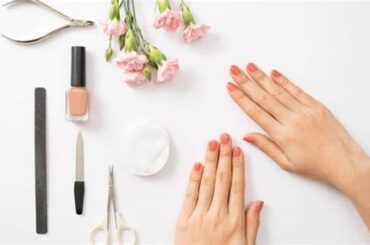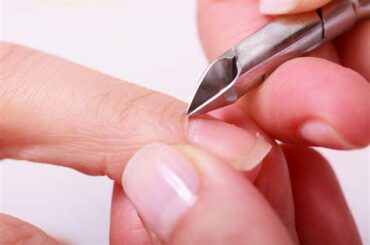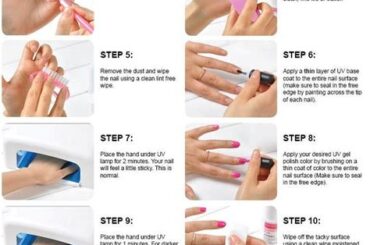Nail care is an essential part of many people’s beauty routines, but with so much information out there, it can be hard to separate fact from fiction. There are plenty of myths about nail care that have been passed down through the years, and it’s time to set the record straight. In this blog post, we’ll be debunking some of the most common nail care myths and shedding light on the truth behind them. From whether cutting your nails makes them grow faster to the effects of using nail polish and nail strengtheners, we’ll delve into the facts that you need to know for proper nail care. So, if you want to finally understand what’s really best for your nails, keep reading as we bust these top nail care myths and separate fact from fiction.
Myth: Cutting your nails makes them grow faster
Many people have heard the myth that cutting your nails more frequently will make them grow faster. This belief has been passed down through generations and is often accepted as fact. However, the truth is that nail growth is not affected by the frequency of trimming, but rather by genetics, nutrition, and overall health.
When you cut your nails, you are simply removing the dead cells that form the nail plate. This does not stimulate the nail bed or affect the rate of nail growth in any way. In fact, proper nail trimming can actually promote strong and healthy nail growth by preventing breakage and splitting.
It is important to keep in mind that nails grow at different rates for each individual, and there is no magic method to accelerate the process. Instead, focus on maintaining good nail care habits and overall wellness to support healthy nail growth.
Next time you hear someone claim that cutting your nails will make them grow faster, you can confidently debunk this nail care myth with the facts about nail growth.
Fact: Proper nail trimming promotes strong and healthy growth
Many people believe the myth that cutting your nails makes them grow faster. In reality, proper nail trimming is essential for promoting strong and healthy nail growth. When nails are trimmed regularly and maintained at the right length, they are less likely to become weak, split, or break. This allows them to grow evenly and maintain their strength.
Proper nail trimming also helps to prevent ingrown nails, which can be painful and lead to infections. When nails are cut straight across and not too short, the risk of ingrown nails is greatly reduced. This promotes overall nail health and ensures that they grow in a strong and healthy manner.
It’s important to use the right tools and techniques when trimming nails to avoid damage. Using sharp, clean nail clippers or scissors and filing the edges gently can help maintain the nail’s strength and prevent breakage. This, in turn, promotes healthy growth and reduces the likelihood of brittle and weak nails.
In conclusion, the myth that cutting your nails makes them grow faster is false. Proper nail trimming is crucial for promoting strong and healthy growth. By maintaining the right length, using the proper tools, and practicing good nail care, you can ensure that your nails grow in a healthy and strong manner.
Myth: Nails need to breathe without polish
Many people believe the myth that nails need to breathe without polish, but the fact is that nails do not actually need to breathe in the way that skin does. Nails are made of a protein called keratin, and they receive their nutrients and oxygen from the blood supply, not the air. While it is true that constantly having nail polish on can lead to discoloration and weakening of the nails, it is not necessary to give them a breather without polish in order to stay healthy. Proper nail care, including using nail polish and nail strengtheners, can actually promote strong and healthy nail growth.
It is important to avoid the misconception that nails need to be left bare in order to be healthy. On the contrary, using nail polish and nail strengtheners can protect the nails from damage and promote their strength and resilience. Additionally, keeping the nails polished can prevent them from becoming dry and brittle, especially in harsh environmental conditions.
Overall, it is essential to debunk the myth that nails need to breathe without polish. Good nail care involves using nail polish and nail strengtheners to maintain strong and healthy nails. By providing proper protection and nourishment to the nails, you can ensure that they remain in optimal condition without the need for them to breathe without polish.
When it comes to nail care, it is important to focus on promoting strength and health rather than adhering to myths about nail breathing. By understanding the facts and taking proper care of your nails, you can maintain their beauty and strength without having to leave them bare.
Fact: Good nail care includes using nail polish and nail strengtheners
Contrary to popular belief, using nail polish and nail strengtheners is actually an important part of maintaining healthy nails. Nail polish not only adds a pop of color to your nails, but it also acts as a protective layer, preventing them from becoming weak and brittle. Additionally, nail strengtheners are formulated to promote strong and healthy nail growth, making them an essential component of a good nail care routine.
Many people believe that letting nails breathe without polish is necessary for their health, but in reality, using quality polishes and strengtheners can actually benefit the nails. When choosing a nail polish, look for formulas that are free from harmful chemicals such as formaldehyde, toluene, and dibutyl phthalate, which can be damaging to the nails in the long run.
Furthermore, nail strengtheners are specifically designed to nourish and fortify the nails, helping to prevent breakage and promote growth. Look for products that contain ingredients such as keratin, protein, and vitamins to ensure that your nails receive the nutrients they need to stay strong and healthy.
In conclusion, incorporating nail polish and nail strengtheners into your nail care routine is essential for maintaining the health and strength of your nails. By choosing high-quality products and using them regularly, you can enjoy beautiful, healthy nails that are less prone to damage and breakage.
Myth: Gel manicures always damage your nails
Gel manicures have gained popularity in recent years due to their long-lasting and durable finish. However, there is a common misconception that gel manicures always damage your nails. This myth has caused many people to hesitate before getting a gel manicure, fearing that it will leave their nails weak and brittle.
Contrary to popular belief, gel manicures do not always damage your nails. When done properly and removed carefully, gel manicures can actually be a safe and effective way to enhance the appearance of your nails without causing harm.
One of the main reasons why gel manicures are often associated with nail damage is improper removal. Peeling or picking off the gel polish can lead to the thinning and weakening of the nails. It is essential to have gel manicures removed by a professional or to follow the proper removal process at home to minimize the risk of damage.
In addition, maintaining the health of your nails before and after getting a gel manicure is crucial. Using nail strengtheners and moisturizing products can help prevent damage and promote overall nail health.
Fact: Proper removal and maintenance minimize damage from gel manicures
Gel manicures have become increasingly popular in recent years due to their long-lasting, chip-resistant nature. However, there is a common misconception that gel manicures always damage your nails. In fact, proper removal and maintenance can minimize any potential damage. When gel polish is removed incorrectly, it can peel off the top layers of the nail, leaving them weak and brittle. However, by following the proper removal process, you can avoid this damage altogether.
One key factor in minimizing damage from gel manicures is to never peel off the gel polish. Peeling can cause significant damage to the nail bed and result in thin, weak nails. Instead, it’s important to visit a professional nail technician who can safely remove the gel polish using the appropriate techniques and tools. This will ensure that the top layers of the nail remain intact and undamaged.
Furthermore, regular maintenance and care can also contribute to minimizing any potential damage from gel manicures. After the gel polish has been removed, it’s essential to keep the nails hydrated and nourished. Using a nail strengthening treatment or cuticle oil can help to restore moisture and promote healthy nail growth. Additionally, giving your nails a break from gel manicures and allowing them to breathe can further minimize any potential damage.
In summary, while gel manicures have the potential to cause damage to the nails, proper removal and maintenance techniques can significantly minimize this risk. By avoiding peeling off the gel polish and following a regular nail care routine, you can enjoy the long-lasting benefits of gel manicures without compromising the health of your nails.
Myth: White spots on nails indicate a calcium deficiency
One common myth about nails is that white spots indicate a calcium deficiency. However, the fact is that white spots on nails are usually harmless and are more commonly caused by trauma to the nail. This trauma can come from something as simple as bumping your nail against a hard surface, or from more extreme activities like aggressively pushing back your cuticles. While a calcium deficiency can certainly cause other symptoms in the body, it is not typically a direct cause of white spots on the nails.
It is important to recognize that our nails can often be a good indicator of our overall health, but in the case of white spots, they are not necessarily a sign of a nutrient deficiency. Instead, it is more likely that they are a result of minor nail trauma.
That being said, it is always a good idea to have any changes in your nails checked out by a medical professional, especially if you are concerned about any potential health issues. A doctor can help determine the cause of any changes in your nails and provide appropriate advice or treatment if necessary.
Ultimately, understanding the truth behind common myths about nail health can help you take better care of your nails and avoid unnecessary worry. Instead of assuming that white spots indicate a calcium deficiency, it is important to consider other potential causes and seek professional guidance when needed.
Fact: White spots are usually harmless and caused by trauma
One common myth about white spots on nails is that they indicate a calcium deficiency. However, the fact is that these spots are usually harmless and caused by trauma to the nail. Whether it’s from slamming your finger in a door, hitting your hand on a hard surface, or even just from regular wear and tear, these white spots are simply the result of minor injuries to the nail bed.
It’s important for people to understand that these white spots are not a cause for concern. They will typically grow out and disappear on their own as the nail continues to grow. In most cases, no special treatment is needed, and the nail will return to its normal appearance after some time.
While it’s always a good idea to maintain a balanced diet that includes plenty of calcium and other essential nutrients, white spots on the nails are not a reliable indicator of a calcium deficiency. It’s more important to focus on overall nail care and maintenance to ensure that they remain healthy and strong.
Remember, if you notice any changes in the appearance of your nails, it’s best to consult a healthcare professional for an accurate assessment. They can provide personalized advice and recommendations based on the specific condition of your nails.
Myth: Hydrogen peroxide whitens stained nails
Many people believe that using hydrogen peroxide can effectively whiten stained nails. However, this is actually a myth. While hydrogen peroxide is known for its whitening properties, it can actually harm nails, causing dryness and weakening. Using hydrogen peroxide on nails can lead to increased brittleness and vulnerability to breakage, which is the opposite of the healthy and strong nails that most people desire.
It is important to seek out alternative methods for whitening stained nails, such as using a gentle nail buffer to remove surface stains or applying a nail whitening treatment specifically designed for the nails. These methods can help to achieve the desired whiteness without causing harm to the nails themselves.
Understanding the fact that hydrogen peroxide can actually damage nails is crucial for maintaining overall nail health. By avoiding the use of hydrogen peroxide and opting for safer and more effective methods of whitening stained nails, individuals can promote the strength and longevity of their nails while still achieving a bright and clean appearance.
Next time you reach for the hydrogen peroxide in an attempt to whiten your stained nails, consider the potential consequences and explore alternative options that prioritize the health and well-being of your nails.
Fact: Hydrogen peroxide can actually harm nails, causing dryness and weakening
Many people believe that using hydrogen peroxide is a good way to whiten stained nails. However, the fact is that hydrogen peroxide can actually harm your nails. When applied to the nails, hydrogen peroxide can cause dryness and weakening of the nails, leaving them more prone to breakage and damage.
It is important to be cautious when using chemicals on your nails, as they are delicate and can easily be damaged. Instead of using hydrogen peroxide, consider using gentler methods for whitening stained nails, such as lemon juice or a mixture of baking soda and water.
Additionally, it’s important to maintain proper nail care habits to keep your nails healthy and strong. This includes keeping your nails well-trimmed, moisturized, and protected with a base coat when using nail polish.
By being aware of the potential harm that hydrogen peroxide can cause to your nails, you can make informed choices about how to care for and maintain the health of your nails.

